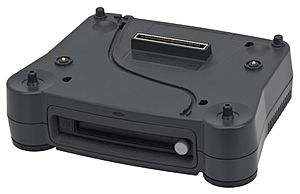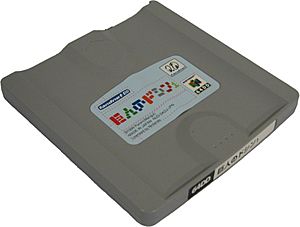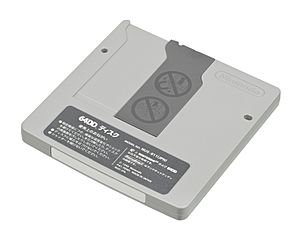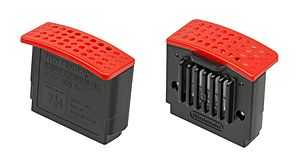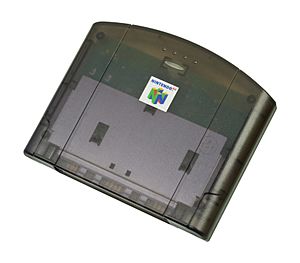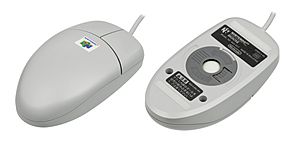64DD facts for kids
 |
|
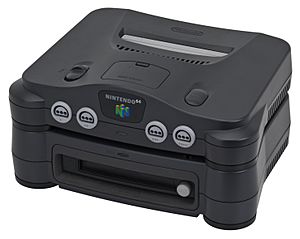
A Nintendo 64 with the 64DD installed
|
|
| Developer | Nintendo, Alps Electric |
|---|---|
| Manufacturer | Alps Electric |
| Type | Video game console peripheral |
| Generation | Fifth generation |
| Release date |
|
| Retail availability | December 13, 1999 - February 28, 2001 |
| Discontinued |
|
| Units sold | 15,000+ |
| Media | Magnetic disk (64 MB) |
| Storage | 36 megabit ROM (audio/font) |
| Connectivity | 22.8 kbps dialup modem |
| Online services | Randnet |
| Predecessor | Satellaview |
The 64DD (pronounced "sixty-four D.D.") was an add-on for the Nintendo 64 game console. Nintendo developed it, and it was first announced in 1995. After many delays, it finally came out in Japan on December 13, 1999. The "64" in its name refers to the Nintendo 64 console. It also refers to the 64 megabytes (MB) of storage on its special disks. "DD" stands for "disk drive" or "dynamic drive."
The 64DD plugged into the bottom of the Nintendo 64. It let the console use special 64MB magnetic disks. These disks could store more game data. They could also be rewritten, meaning you could save new things on them. The 64DD also had a real-time clock. This allowed games to have worlds that changed even when the console was off. It also had a library of fonts and sounds. This helped games save space on the disks.
With the 64DD, players could create movies, characters, and animations. They could use these creations in different games. The system could also connect to the internet using a service called Randnet. This allowed for online shopping, playing games with others, and sharing media. Nintendo hoped the 64DD would lead to new kinds of games. Many games were planned for it over several years.
However, only ten software titles were released for the 64DD. It was stopped in February 2001. The 64DD was not a success. Only about 15,000 units were sold. It was never released outside of Japan. Most games planned for the 64DD were either released as regular Nintendo 64 games, moved to other consoles like the GameCube, or simply canceled.
Contents
How the 64DD Was Made
Early Ideas
When Nintendo first talked about its new console (Project Reality) in 1993, they thought about how games would be stored. They considered using cartridges, CDs, or even something completely new. At first, cartridges were chosen because they were faster. They allowed games to load quickly and characters to move smoothly.
Nintendo also thought about how much the console would cost. Adding a CD-ROM drive would make the Nintendo 64 too expensive. So, they decided to use their own special floppy disks instead. Game designer Shigesato Itoi explained that CDs hold a lot of data. But DD disks hold a good amount and can save new data. Cartridges hold the least data but are the fastest. By adding the DD, Nintendo hoped to create many new types of games.
Nintendo also wanted to add online features. They thought about online multiplayer games first, even before web browsing. Some game makers planned to add online multiplayer to their games using the 64DD. However, these plans changed later. The final Randnet service did not include online multiplayer gaming.
First Look and Delays
Nintendo first showed the 64DD at a trade show in 1995. They planned to release it in 1997. The full details of the 64DD were shown in November 1996. Nintendo said its design was final. They also said many game developers would support it. Games like Super Mario 64 2 and Zelda 64 were mentioned. New games like Cabbage and Emperor of the Jungle were also planned.
A working version of Super Mario 64 was shown. It ran from a disk to show how the 64DD worked. A graphics app was also shown. It could put audience photos onto 3D characters. This feature later became part of Mario Artist: Talent Studio. Nintendo also said the 64DD would come with a RAM expansion. This would make the Nintendo 64 more powerful.
Many people in the gaming press felt the 64DD reveal was not as exciting as promised. They still didn't know much about the games or when it would be released. Zelda 64 (which later became The Legend of Zelda: Ocarina of Time) was seen as a very important game for the 64DD.
The 64DD became known for its many launch delays. It was delayed for two years. These delays caused problems for Nintendo and its partners. In 1999, some people called it "the most elusive piece of vaporware." Vaporware is a product that is announced but never released, or is released much later than planned.
Nintendo kept delaying the 64DD's release. They said it was because the disks and the drive were taking a long time to develop. They also said they wouldn't release it until enough games were ready. Many games were in development, including Donkey Kong 64. Nintendo confirmed the 64DD would have internet features.
At a show in November 1997, the 64DD was shown again. But its release was delayed even more. It was pushed back from March 1998 to June 1998. People started to wonder if the 64DD would ever be a big success. Zelda 64 was moved from the 64DD to a regular cartridge. This was because the 64DD might not have enough players to support such a big game. Also, cartridges were faster for certain game features.
Nintendo's game designer, Shigeru Miyamoto, said it was hard to explain the 64DD's potential. He felt it would have been easier if it came out with the Nintendo 64. He said almost every new Nintendo 64 project was based on the 64DD.
More delays followed. The 64DD was not even shown at the E3 game show in 1998. This made many people think it might be canceled. Because of the lack of ready software, Nintendo even canceled its Space World show for 1998.
In April 1999, Nintendo announced a new launch date for June 1999. They also said there were no plans to release it outside Japan. In June 1999, the Randnet online service and modem were almost ready. This gave new hope to the 64DD. Nintendo was confident they would sell 500,000 units.
By August 1999, Randnet was set to launch on December 1, 1999. The 64DD pre-orders were delayed again. Earthbound 64, a highly anticipated game, was moved from disk to cartridge. This made people think the 64DD might be delayed or canceled even more.
Launch and End
The 64DD finally launched on December 13, 1999. It was only available in Japan. It was sold as a package called the Randnet Starter Kit. This kit included six games sent by mail every two months. It also included one year of internet service. Nintendo expected it to be a commercial failure. So, they sold it mainly through mail order at first. Later, a few units and games were sold in stores.
In August 2000, Nintendo showed off the GameCube and Game Boy Advance. Many people saw this as the unofficial end of the 64DD. Nintendo did not talk about the 64DD at all at this event.
In October 2000, Nintendo announced that the 64DD and Randnet would be stopped. They had about 15,000 active users. Both were officially discontinued in February 2001. Only ten 64DD disks were ever released. Most games planned for it were either released on larger Nintendo 64 cartridges, moved to other consoles, or canceled.
How the 64DD Worked
| Dual storage | CD-ROM | |
|---|---|---|
| Cartridge | 64DD | |
| low capacity 4–64 MB |
moderate capacity 64 MB |
large capacity 650 MB |
| read/write | read/write | read-only |
| major production, 10–12 weeks |
easier production | easiest production, 7–10 days |
| expensive media |
cheaper media |
cheapest media |
| cheap system integration |
moderately priced drive |
expensive drive |
| fastest 5–50 MB/s instantaneous |
moderate 503.70–1043.39 kB/s 75 ms avg |
slowest 300 kB/s peak 200+ ms avg |
| proprietary | proprietary | PC-copyable |
| durable | magnetic | scratchable |
Nintendo designed the 64DD to allow new types of games. It did this with three main features:
- It used both cartridges and disks.
- It had a new real-time clock (RTC).
- It could connect to the internet.
The Nintendo 64 used fast cartridges. These cartridges were expensive and couldn't be rewritten. They also held less data. The 64DD added magnetic disks. These disks held more data, could be rewritten, and were cheaper. But they were not as fast as cartridges.
The 64DD used its own special magnetic floppy disks. They looked like the larger Zip disks used on computers. These disks were made by Nintendo and had copy protection. They were Nintendo's answer to the cheaper CD format. CDs held more data but were slower. They were also easier to copy on computers. For example, a CD could hold 650 MB of data. But it was much slower to load. A Nintendo 64 cartridge held 4 to 64 MB but loaded instantly. The 64DD disk held 64 MB and was moderately fast.
For example, the game The Legend of Zelda: Ocarina of Time was first planned for the 64DD disk. But it was moved to a faster cartridge. This was done to make the game run better and cost less.
The 64DD disks could store up to 38MB of new data. This was a big improvement for games. It allowed for new game types and social gaming. Many Nintendo 64 games had hidden code to detect the 64DD. This was for planned expansion disks that were never released. These expansions could have added sequels, new levels, or mini-games. They could also store things players created.
The 64DD's real-time clock (RTC) allowed game worlds to change over time. This happened even when the console was turned off. For example, the game Cabbage used this feature. It was a pet breeding game where your virtual pet would grow even when you weren't playing.
The system also came with a modem cartridge for Randnet. This connected the console to the internet.
The 64DD had better font and audio libraries. This saved space on game cartridges and disks. A special chip helped the disks work and send data to the console. Like most disk-based consoles, the 64DD had a menu that appeared when no game was inserted. The 64DD also came with a 4MB Expansion Pak. This increased the Nintendo 64's total memory to 8MB.
Accessories
The 64DD Randnet package included a modem to connect to the internet. It also had the 4MB RAM Expansion Pak. Other accessories included a keyboard, a mouse, and a Capture Cassette. The Capture Cassette allowed users to input audio and video.
The modem cartridge was made with other companies. It was the only official way to connect the Nintendo 64 to the internet.
Randnet Online Service
In April 1999, Nintendo started a new partnership with a Japanese company called Recruit. Together, they created a new online service for the 64DD called Randnet. Randnet was a mix of "Recruit and Nintendo network." It operated only in Japan from December 13, 1999, to February 28, 2001.
The Randnet service allowed users to browse the internet. It also had special areas for members only. Users could share things they created, like artwork. The subscription fee included the internet service, the 64DD hardware, and game disks sent by mail.
The Randnet Starter Kit came with everything needed to use the service:
- 64DD: The disk drive system that could write data.
- Nintendo 64 Modem: For connecting to the internet.
- Expansion Pak: This added 4MB of RAM to the Nintendo 64, making it 8MB total.
- Randnet Browser Disk: This disk let users access the "members only" pages and the internet.
Once online, players could:
- Editing Tool: Create custom characters to interact with others.
- Information Exchange: Use online message boards and send emails.
- Community: Talk with game creators.
- Internet Surfing: Browse the internet using a special web browser made for TVs.
- Postcards: Mario Artist games were supposed to let users design and print postcards to send by mail.
- E-commerce: A service called GET Mall sold CDs, books, and 64DD games.
- Digital Magazine: Plans included checking sports scores, weather, and news online. Only horse racing features were released.
Nintendo had also promised other features that were never released:
- NES games: An emulator was ready for downloading old NES games.
- Battle Mode: Play against other gamers online.
- Observation Mode: Watch other players' game sessions.
- Beta Test: Download sample levels from upcoming games.
- Music Distribution: Listen to music, including unreleased songs.
The Randnet service was popular among the few 64DD owners. However, it did not get enough users to keep going. In October 2000, Nintendo announced it would close. About 15,000 people were subscribed at that time. Nintendo offered to buy back the hardware from customers. They also gave free service until it closed. Randnet officially closed on February 28, 2001.
One of the most important game series for Randnet was Mario Artist. These games let users share their artwork online. There were also contests and special events. Players could even make papercraft figures. They would design characters in Mario Artist: Polygon Studio, upload the data to Randnet, and then print them out to cut and fold.
Games for 64DD
Released Games
Only ten disks were released for the 64DD. This included nine games and one internet utility disk.
| Title | Release date |
|---|---|
| Mario Artist: Paint Studio (マリオアーティスト ペイントスタジオ) |
December 13, 1999 |
| Doshin the Giant (巨人のドシン1, Kyojin no Doshin 1) |
|
| Randnet Disk (ランドネットディスク) |
February 23, 2000 |
| Mario Artist: Talent Studio (マリオアーティスト タレントスタジオ) |
|
| SimCity 64 (シムシティー64) |
|
| F-Zero X Expansion Kit (エフゼロ エックス エクスパンション キット) |
April 21, 2000 |
| Japan Pro Golf Tour 64 (日本プロゴルフツアー64, Nippon Puro Gorufu Tsua 64) |
May 2, 2000 |
| Doshin the Giant: Tinkling Toddler Liberation Front! Assemble! (巨人のドシン解放戦線 チビッコチッコ大集合, Kyojin no Doshin Kaihō Sensen Chibikko Chikko Daishūgō) |
May 17, 2000 |
| Mario Artist: Communication Kit (マリオアーティスト コミュニケーションキット) |
June 29, 2000 |
| Mario Artist: Polygon Studio (マリオアーティスト ポリゴンスタジオ) |
August 29, 2000 |
Games That Were Planned
More than 60 games were announced for the 64DD. Most of these were either released as regular Nintendo 64 cartridges, completely canceled, or moved to other consoles.
- Cabbage (never released, but influenced games like Nintendogs)
- Creator (later became part of the Mario Artist series)
- Derby Stallion 64 (released on cartridge)
- Doubutsu Banchou (released on GameCube as Cubivore: Survival of the Fittest)
- Dōbutsu no Mori (released as a cartridge in Japan, later became Animal Crossing on GameCube)
- Dragon Warrior VII (released on PlayStation)
- Emperor of the Jungle (canceled)
- Far East of Eden: Oriental Blue (canceled, became a GBA game)
- Fire Emblem 64 (canceled, parts used in a GBA game)
- Hybrid Heaven (released on cartridge)
- Kirby 64: The Crystal Shards (released on cartridge)
- Mario Artist: Game Maker (canceled)
- Mario Artist: Sound Maker (canceled)
- Mario Party 2 (released on cartridge)
- Mission: Impossible (released on cartridge)
- Morita Shogi 64 (released on cartridge)
- Mother 3 (EarthBound 64) (canceled for 64DD, later released on GBA)
- Mysterious Dungeon: Shiren the Wanderer 2 (released on cartridge)
- Ogre Battle Saga (released on cartridge)
- Pokémon Snap (released on cartridge)
- Pokémon Stadium (released on cartridge)
- Pokémon Stadium 2 (released on cartridge)
- Resident Evil Zero (released on GameCube)
- Seaman (released on Dreamcast)
- SimCopter 64 (canceled)
- SnowSpeeder (released on cartridge)
- Super Mario 64 2 (canceled)
- Super Mario RPG 2 (released on cartridge as Paper Mario)
- Ultra Donkey Kong (released on cartridge as Donkey Kong 64)
- Ura Zelda (canceled, but later released for GameCube as Master Quest)
- Yoshi's Island 64 (released on cartridge as Yoshi's Story)
- Zelda 64 (released on cartridge as The Legend of Zelda: Ocarina of Time)
- Zelda Gaiden (released on cartridge as The Legend of Zelda: Majora's Mask)
See also
 In Spanish: Nintendo 64DD para niños
In Spanish: Nintendo 64DD para niños
- Famicom Modem
- Famicom Disk System
- Sega CD - a similar add-on for the Sega Genesis
- Satellaview


